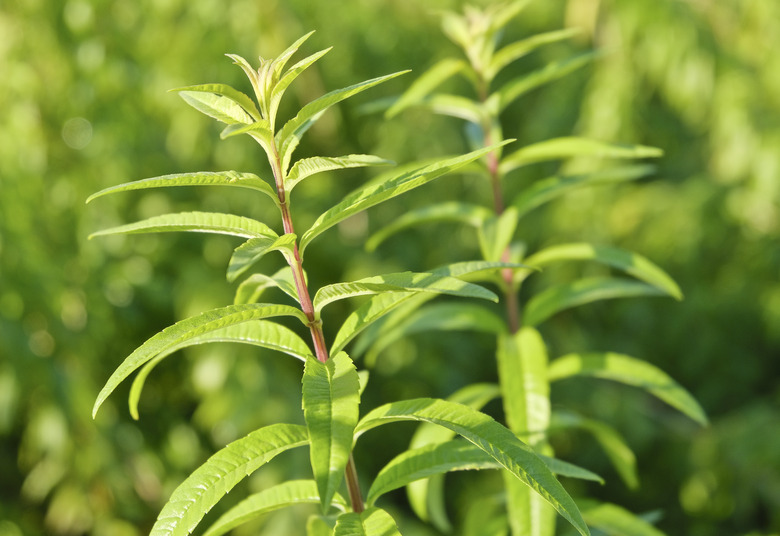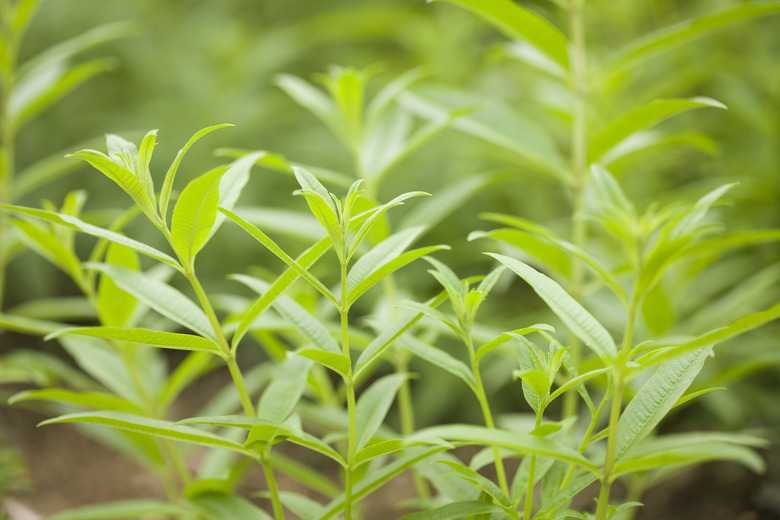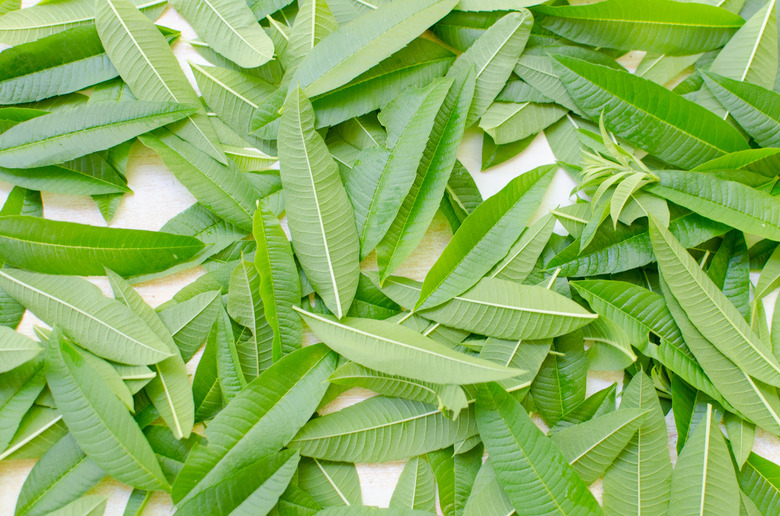How To Grow Lemon Verbena
We may receive a commission on purchases made from links.
Lemon verbena (Aloysia citriodora) is a low-maintenance, woody shrub with glossy leaves used for culinary and medicinal purposes. Lemon verbena shrubs are broadleaf evergreens when grown in United States Department of Agriculture plant hardiness zones 8 through 10.
Best Uses for Lemon Verbena
Best Uses for Lemon Verbena
Lemon verbena is an aromatic herb but is also frequently used as a garden ornamental. This large shrub is a great addition to the backyard landscape, with fragrant, shiny leaves that fill the backyard with a sweet, lemony fragrance. It grows to 4 feet tall and wide in warm zones and produces white or lilac flowers in midsummer. It can be grown as an annual in colder zones.
Lemon verbena has both culinary and medicinal uses as well. The leaves and flowers add a zesty lemon flavor to teas, fruit salads, desserts and jellies. They also work well in potpourris and are used in some cosmetics. As an herbal medicine, lemon verbena has been used to treat colds, fevers, dyspepsia, and diarrhea. The shrubs work well in an herb garden, a fragrance garden, or even a vegetable garden. You can plant them next to walkways, where you can appreciate the lemony fragrance as you walk by.
How to Grow Lemon Verbena
How to Grow Lemon Verbena
Because growing lemon verbena from seeds can be a long and trying procedure, most people grow this shrub from seedlings purchased at the garden store or those rooted from cuttings. Here are a few tips on how to successfully grow lemon verbena from seedlings:
- If you are
growing multiple plants as annuals, space them 6 to 9 inches apart. - If you
live in USDA plant hardiness zones 8 or warmer, you
can grow them as perennials, and they should be planted at least 3 feet
apart as the shrubs can spread 4 to 6 feet. - If you are planting seedlings grown in containers, be sure to set them into the soil at the same level as they were in
the pots. Dig a hole that is wider than the pot, set the plant in the hole, pat dirt
into the sides and water well.
In What Zone Does Lemon Verbena Grow Best?
In What Zone Does Lemon Verbena Grow Best?
Lemon verbena is native to Argentina and Chile, so it's grows best in the warm climates of USDA zones 8 through 11. However, you should take special precautions in zone 8 if you intend to winter your lemon verbena outdoors. Stop watering the shrubs before the ground freezes in autumn so that the roots won't be wet when they freeze, and plant them in a sheltered spot to protect them from winter winds.
When Should You Plant Lemon Verbena?
When Should You Plant Lemon Verbena?
If you are planting lemon verbena as an annual, get the seedlings into the ground soon after the final frost in spring. This gives you maximum time to enjoy the plant. If the shrub is hardy in your region, you can plant it in the spring or in the fall.
Soil, Sunlight, and Water Recommendations for Lemon Verbena
Soil, Sunlight, and Water Recommendations for Lemon Verbena
Good drainage is very important when you are growing lemon verbena. The shrub prefers loose, well-draining soil — like soil with a high sand content — and prefers that the soil is slightly alkaline. It does poorly in clay and highly acidic soils. It's good to include organic material in the soil but don't make it too moisture-retentive since the shrub's roots will rot.
Full sun is generally the best exposure for lemon verbena. This is an herb that loves a sunny location and grows best in one that gets at least six hours of daily direct sun. In Northern regions, pick a site that also gets reflected light from a white fence or wall. However, if it gets very hot in your region in summer, plant lemon verbena where it will get a little afternoon shade.
Lemon verbena needs water, but it is not a big drinker. Assuming you give this shrub the excellent drainage it requires, it can tolerate a little water or a lot. Aim for something in the middle. The best idea is to keep the soil moist but never wet.
How to Propagate Lemon Verbena
How to Propagate Lemon Verbena
Save money by making your own lemon verbena plants from cuttings. Experts recommend taking stalks in the summer when the plants are growing rapidly. Cut off a stem without any blossoms, making the snip just above a leaf or flower node. Cut off all leaves on the cutting except the top two sets and then poke the cut end into moist potting mix, with at least one node below the soil. Use 3-inch pots so the cuttings don't have to be transplanted too quickly. You can cover the cutting with a plastic bag to create a personal greenhouse for the cutting, making sure you keep it out of direct sun and providing enough water to keep the soil moist until new foliage begins to grow. At that point, it can be transplanted.
How to Winterize Lemon Verbena
How to Winterize Lemon Verbena
If you are growing lemon verbena in an area with chilly winters, you have three choices:
- Grow it as an
annual, disposing of the dead plants every winter and replacing them each spring. - Grow lemon verbena in a pot and bring it indoors in winter. Although the leaves may fall off
while the plant is indoors, they will grow back as the days grow longer.
Remember that plants without leaves will use a lot less water. Start watering again in spring and watch your plant come quickly out of dormancy. - The third solution only applies if you live in USDA zones 8 through 11. Although you can leave your plant outside all winter in these zones, it may still enter dormancy if temperatures dip below 40 degrees Fahrenheit. To prepare them for this, cut down on irrigation a few weeks before cold weather sets in.
Tip
A change in temperature or day length is a shock for lemon verbena. In its native habitat, this broadleaf evergreen shrub enjoys mild temperatures and stable daylight. Close to the equator, winter looks a lot like summer. While the herb will adapt to different climes, you can expect it to drop its leaves and go into dormancy if temperatures drop or the days are shorter. Reduce water and wait until spring.
How to Harvest Lemon Verbena
How to Harvest Lemon Verbena
You can harvest lemon verbena leaves whenever you want and as often as you wish throughout the growing season.
Take individual leaves or stems of leaves. For the strongest lemon flavor, take leaves at the time the plant flowers. Note that when you cut a stem, your plant will produce new growth directly under the place you cut. Clipping stems instead of just leaves helps keep the shrub compact and contained. You can remove up to half of the plant if need be.
It's practical to figure out a way to store your lemon verbena before you harvest an entire stem. One way is to dry the leaves by bundling stems together and hanging them upside down in a dark, dry location. Dried leaves can be stored in sealed containers. Lemon verbena also stores well when it is frozen with water in ice cube trays.
Common Pests and Other Problems for Lemon Verbena
Common Pests and Other Problems for Lemon Verbena
Unfortunately, lemon verbena has a few pests that can cause problems if left unabated:
- Aphids: These are small, soft-bodied bugs, and a few of them won't do any harm to your lemon verbena. However, when the aphid infestation is severe, it's another story. They tend to hang out on the underside of leaves. Aphids have mouthparts that can pierce leaves and suck out the plant juices. When there are many of them, this damage can stunt the plant's growth. Try blasting the bugs off the leaves with water from your garden hose as a non-chemical pest-control method.
- Spider mites: These are not spiders, but they look spidery with their many little legs. These are tiny insects about the size of a pinhead, and they can be red, yellow or green. Like aphids, they have piercing/sucking mouthparts that allow them to feast on your plants. They like warm weather and are more likely to show up in summer in most regions. Look for tiny holes on leaves, webbing created by the pests and dropping foliage. Use neem oil spray to deal with an infestation.
- Mealybugs: Looking more like a fuzzy fungus than insect, these pests suck plant juices out of the leaves and
stems of lemon verbena shrubs, producing stunted or deformed leaf growth. Look for a cottony mass on new growth, along the veins of leaves and at
the leaf joints. Over time, they can cause a lot of damage to a plant. If there are just a few, wipe them off with alcohol on cotton swabs. For a bigger infestation, spray them with neem oil. - Leafminers: Adult leafminers are small and have a yellow stripe, but it's actually their larvae that are the issue, chewing tunnels through leaves. The tunnels go this way and that way, like mazes. Leaves can yellow and/or fall from the shrub branches. Remove the infected leaves.
- Scale: These insects look like small brown bumps on foliage. This is a parasitic pest that feeds on plant juices. A scale infestation can cause dying leaves and branches. Neem oil works to get rid of them.
Common Diseases for Lemon Verbena
Common Diseases for Lemon Verbena
Lemon verbena has a few common diseases to watch out for, including:
- Botrytis blight: A fungal disease that produces tan spots on the leaves of lemon verbena followed by rotting at the crown. Look for dusty gray fungal growth on infected plant parts. Prevent this by not crowding the shrubs, watering from the ground instead of from above and allowing air circulation between the plants. Cut out and remove infected flowers and leaves.
- Powdery mildew: A fungal disease that looks like white powder sprinkled on your plant, usually seen on the top of the leaves. Spacing the plant and keeping irrigation off the foliage helps prevent this. Preventative fungicides can help as well.
- Pythium root rot: This disease causes plants to wilt. The roots will be dark brown and can be soft. Keeping water off foliage, allowing for air circulation between shrubs and using preventative fungicides can prevent this deadly disease.


